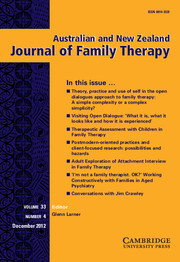Crossref Citations
This article has been cited by the following publications. This list is generated based on data provided by Crossref.
Gladstone, Brenda M.
McKeever, Patricia
Seeman, Mary
and
Boydell, Katherine M.
2014.
Analysis of a Support Group for Children of Parents With Mental Illnesses.
Qualitative Health Research,
Vol. 24,
Issue. 9,
p.
1171.
Dujardin, Céline
Ferring, Dieter
and
Lahaye, Willy
2014.
La place des parents dans la résilience familiale. Une métasynthèse qualitative.
Les Cahiers Internationaux de Psychologie Sociale,
Vol. Numéro 104,
Issue. 4,
p.
697.
Power, Jennifer
Cuff, Rose
Jewell, Hanna
McIlwaine, Fiona
O'Neill, Imogen
and
U'Ren, Greg
2015.
Working in a family therapy setting with families where a parent has a mental illness: practice dilemmas and strategies.
Journal of Family Therapy,
Vol. 37,
Issue. 4,
p.
546.
Cooper, Vicki
and
Reupert, Andrea
2017.
“Let’s Talk About Children” resource: A parallel mixed method evaluation.
Social Work in Mental Health,
Vol. 15,
Issue. 1,
p.
47.
Kalebic, Natasha
Adams, Alex
Bezeczky, Zoe
Argent, Sarah
Bagshaw, Ruth
and
Taylor, Pamela J.
2020.
Social workers’ perspectives on people parenting while patients in a secure hospital.
The Journal of Forensic Psychiatry & Psychology,
Vol. 31,
Issue. 3,
p.
364.
McCartan, Claire
Davidson, Gavin
Donaghy, Mary
Grant, Anne
Bunting, Lisa
Devaney, John
and
Duffy, Joe
2022.
Are we starting to ‘think family’? evidence from a case file audit of parents and children supported by mental health, addictions and children's services.
Child Abuse Review,
Vol. 31,
Issue. 3,
Radley, Jessica
Sivarajah, Nithura
Moltrecht, Bettina
Klampe, Marie-Louise
Hudson, Felicity
Delahay, Rachel
Barlow, Jane
and
Johns, Louise C.
2022.
A Scoping Review of Interventions Designed to Support Parents With Mental Illness That Would Be Appropriate for Parents With Psychosis.
Frontiers in Psychiatry,
Vol. 12,
Issue. ,




